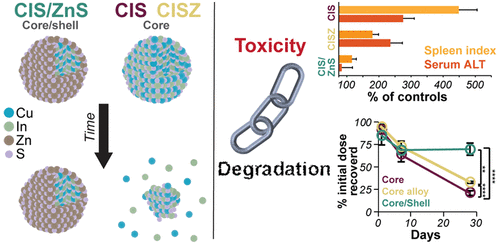当前位置:
X-MOL 学术
›
Nano Lett.
›
论文详情
Our official English website, www.x-mol.net, welcomes your
feedback! (Note: you will need to create a separate account there.)
Shell-Free Copper Indium Sulfide Quantum Dots Induce Toxicity in Vitro and in Vivo.
Nano Letters ( IF 9.6 ) Pub Date : 2020-02-05 , DOI: 10.1021/acs.nanolett.9b05259 Joshua C Kays 1 , Alexander M Saeboe 2 , Reyhaneh Toufanian 2 , Danielle E Kurant 3 , Allison M Dennis 1, 2
Nano Letters ( IF 9.6 ) Pub Date : 2020-02-05 , DOI: 10.1021/acs.nanolett.9b05259 Joshua C Kays 1 , Alexander M Saeboe 2 , Reyhaneh Toufanian 2 , Danielle E Kurant 3 , Allison M Dennis 1, 2
Affiliation

|
Semiconductor quantum dots (QDs) are attractive fluorescent contrast agents for in vivo imaging due to their superior photophysical properties, but traditional QDs comprise toxic materials such as cadmium or lead. Copper indium sulfide (CuInS2, CIS) QDs have been posited as a nontoxic and potentially clinically translatable alternative; however, previous in vivo studies utilized particles with a passivating zinc sulfide (ZnS) shell, limiting direct evidence of the biocompatibility of the underlying CIS. For the first time, we assess the biodistribution and toxicity of unshelled CIS and partially zinc-alloyed CISZ QDs in a murine model. We show that bare CIS QDs breakdown quickly, inducing significant toxicity as seen in organ weight, blood chemistry, and histology. CISZ demonstrates significant, but lower, toxicity compared to bare CIS, while our measurements of core/shell CIS/ZnS are consistent with literature reports of general biocompatibility. In vitro cytotoxicity is dose-dependent on the amount of metal released due to particle degradation, linking degradation to toxicity. These results challenge the assumption that removing heavy metals necessarily reduces toxicity: indeed, we find comparable in vitro cytotoxicity between CIS and CdSe QDs, while CIS caused severe toxicity in vivo compared to CdSe. In addition to highlighting the complexity of nanotoxicity and the differences between the in vitro and in vivo outcomes, these unexpected results serve as a reminder of the importance of assessing the biocompatibility of core QDs absent the protective ZnS shell when making specific claims of compositional biocompatibility.
中文翻译:

无壳硫化铜铟量子点在体内和体外均具有毒性。
半导体量子点(QD)由于其卓越的光物理特性,是用于体内成像的有吸引力的荧光造影剂,但是传统的QD包含有毒物质,例如镉或铅。硫化铜铟(CuInS2,CIS)QD被认为是无毒且具有临床可翻译性的替代品。然而,先前的体内研究使用的颗粒具有钝化硫化锌(ZnS)壳,从而限制了潜在CIS的生物相容性的直接证据。我们首次在鼠模型中评估了带壳CIS和部分锌合金的CISZ QD的生物分布和毒性。我们显示,裸露的CIS QD会迅速分解,从而引起明显的毒性,如器官重量,血液化学和组织学所见。与裸CIS相比,CISZ具有明显但较低的毒性,而我们对核/壳CIS / ZnS的测量与一般生物相容性的文献报道一致。体外细胞毒性与剂量有关,取决于颗粒降解导致的金属释放量,从而将降解与毒性联系起来。这些结果挑战了以下假设:去除重金属必然会降低毒性:的确,我们发现CIS和CdSe QD之间具有相当的体外细胞毒性,而CIS与CdSe相比在体内造成了严重的毒性。除了突出了纳米毒性的复杂性以及体外和体内结果之间的差异外,这些意外结果还提醒人们在对组成性生物相容性提出特定主张时,评估缺少保护性ZnS壳的核心QD的生物相容性的重要性。
更新日期:2020-02-06
中文翻译:

无壳硫化铜铟量子点在体内和体外均具有毒性。
半导体量子点(QD)由于其卓越的光物理特性,是用于体内成像的有吸引力的荧光造影剂,但是传统的QD包含有毒物质,例如镉或铅。硫化铜铟(CuInS2,CIS)QD被认为是无毒且具有临床可翻译性的替代品。然而,先前的体内研究使用的颗粒具有钝化硫化锌(ZnS)壳,从而限制了潜在CIS的生物相容性的直接证据。我们首次在鼠模型中评估了带壳CIS和部分锌合金的CISZ QD的生物分布和毒性。我们显示,裸露的CIS QD会迅速分解,从而引起明显的毒性,如器官重量,血液化学和组织学所见。与裸CIS相比,CISZ具有明显但较低的毒性,而我们对核/壳CIS / ZnS的测量与一般生物相容性的文献报道一致。体外细胞毒性与剂量有关,取决于颗粒降解导致的金属释放量,从而将降解与毒性联系起来。这些结果挑战了以下假设:去除重金属必然会降低毒性:的确,我们发现CIS和CdSe QD之间具有相当的体外细胞毒性,而CIS与CdSe相比在体内造成了严重的毒性。除了突出了纳米毒性的复杂性以及体外和体内结果之间的差异外,这些意外结果还提醒人们在对组成性生物相容性提出特定主张时,评估缺少保护性ZnS壳的核心QD的生物相容性的重要性。


















































 京公网安备 11010802027423号
京公网安备 11010802027423号